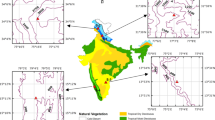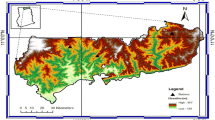Abstract
Knowledge of both vegetation distribution pattern and phenology changes is very important. Their complicated relationship with elevation and accessibility were explored through a geographically weighted regression (GWR) framework in Fujian province, China. The 16-day time series of 250 m Moderate Resolution Imaging Spectroradiometer (MODIS) Enhanced Vegetation Index (EVI) dataset from 2000 to 2010 was applied. Wavelet transform method was adopted to decompose the original time series and construct the annual maximum EVI and amplitude of the annual phenological cycle (ΔEVI). Candidate explaining factors included topographic conditions, accessibility variables and proportions of primary vegetation types. Results revealed very strong positive influence from parameters of elevation and accessibility to big rivers and negative effect from accessibility to resident on both maximum EVI and phenological magnitude through ordinary linear least square (OLS) regression analysis. GWR analysis revealed that spatially, the parameters of topography and accessibility had a very complex relationship with both maximum EVI and phenology magnitude, as a result of the various combinations of environmental factors, vegetation composition and also intensive anthropogenic impact. Apart from the continuously increasing trend of phenology magnitude with increasing altitude, the influence of topography and accessibility on maximum EVI and phenological magnitude generally decreased, even from strongly positive to negative, with increasing altitude or distance. Specially, the most rapid change of correlation coefficient between them was observed within a low elevation or close distance; less variation was discovered within a certain range of medium altitude or distance and their relationship might change above this range. Non-stationary approaches are needed to better characterize the complex vegetation dynamic pattern in Mountain-hill Region.
Similar content being viewed by others
Reference
Abry P (1997) Ondelettes et turbulence. In: Diderot (Ed.) Multiresolutions, algorithmes de decomposition, invariance dechelles. Paris. p 268.
Ahas R, Aasa A, Menzel A, et al. (2002) Changes in European spring phenology. International Journal of Climatology 22(14):1727–1738.
Allen CD, Breshears DD (1998) Drought-induced shift of a forest-woodland ecotone: rapid landscape response to climate variation. Proceedings of the National Academy of Sciences 95(25): 14839–14842.
Atzberger C, Eilers PHC (2011) A time series for monitoring vegetation activity and phenology at 10-daily time steps covering large parts of South America. International Journal of Digital Earth 4(5):365–386.
Beatriz Martínez, Gilabert MA (2009) Vegetation dynamics from NDVI time series analysis using the wavelet transform. Remote Sensing of Environment 113(9):1823–1842.
Ben-Ze’ev E, Karnieli A, Agam N, et al. (2006) Assessing vegetation condition in the presence of biomass burning smoke by applying the Aerosol-free Vegetation Index (AFRI) on MODIS images. International Journal of Remote Sensing 27(15):3203–3221.
Brunsdon C, Fotheringham AS, Charlton ME (1998) Geographically weighted regression — modelling spatial non-stationarity. The Statistician 47(3):431–443.
Chamaille-Jammes S, Fritza H, Murindagomoc F (2006) Spatial patterns of the NDVI-rainfall relationship at the seasonal and interannual time scales in an African savanna. International Journal of Remote Sensing 27(23):5185–5200.
Chang CT, Lin TC, Wang SF, et al. (2011) Assessing growing season beginning and end dates and their relation to climate in Taiwan using satellite data. International Journal of Remote Sensing 32(18):5035–5058.
Crimmins TM, Crimmins MA, David Bertelsen C (2010) Complex responses to climate drivers in onset of spring flowering across a semiarid elevation gradient. Journal of Ecology 98(5):1042–1051.
Fotheringham AS, Brunsdon C, Charlton M (2002) Geographically weighted regression: the analysis of spatially varying relationships. In. John Wiley & Sons Inc, Chichester.
Fujian Tpsgo (2010) Fujian Yearbook. Fujian People’s Publishing House, Fuzhou, China.
Foody GM (2003) Geographical weighting as a further refinement to regression modelling: An example focused on the NDVI-rainfall relationship. Remote Sensing of Environment 88(3):283–293.
Gao Y, Huang J, Li S, et al. (2012) Spatial pattern of nonstationarity and scale-dependent relationships between NDVI and climatic factors-a case study in Qinghai-Tibet Plateau, China. Ecological Indicators 20:170–176.
Gao ZW (2004) Research on forest resource management. Fujian Cartographic Publisher, Fuzhou, China.
Huete A, Didan K, Miura T, et al. (2002) Overview of the radiometric and biophysical performance of the MODIS vegetation indices. Remote Sensing of Environment 83(1–2):195–213.
Iversen M, Bråthen KA, Yoccoz NG, et al. (2009) Predictors of plant phenology in a diverse high-latitude alpine landscape: growth forms and topography. Journal of Vegetation Science 20(5):903–915.
Justice CO, Vermote E, Townshend JRG, et al. (1998) The Moderate Resolution Imaging Spectroradiometer (MODIS): Land remote sensing for global change research. IEEE Transactions on Geoscience and Remote Sensing 36(4):1228–1249.
Li A, Deng W, Liang S, et al. (2010) Investigation on the patterns of global vegetation change using a Satellite-Sensed Vegetation Index. Remote Sensing 2(6):1530–1548.
Liang S, Ge S, Wan L, et al. (2012) Characteristics and causes of vegetation variation in the source regions of the Yellow River, China. International Journal of Remote Sensing 33(5):1529–1542.
Lu SJ (1999) Fujian Climate. China Meteorological Press, Beijin, China.
Martínez B, Gilabert MA (2009) Vegetation dynamics from NDVI time series analysis using the wavelet transform. Remote Sensing of Environment 113(9):1823–1842.
Moulin S, Kergoat L, Viovy N, et al. (1997) Global-Scale Assessment of Vegetation Phenology Using NOAA/AVHRR Satellite Measurements. Journal of Climate 10(6):1154–1170.
Nelson A, Oberthür T, Cook S (2007) Multi-scale correlations between topography and vegetation in a hillside catchment of Honduras. International Journal of Geographical Information Science 21(2):145–174.
Ogden J, Powell JA (1979) A quantitative description of the forest vegetation on an altitudinal gradient in the Mount Field National Park, Tasmania, and a discussion of its history and dynamics. Australian Journal of Ecology 4(3):293–325.
Osborne PE, Foody GM, Suárez-Seoane S (2007) nonstationarity and local approaches to modeling the distribution of wildlife. Diversity and Distributions 13(3):313–323.
Pagano TS, Durham RM (1993) Moderate resolution imaging spectroradiometer (MODIS). Proc. SPIE 1939, Sensor Systems for the Early Earth Observing System Platforms. p2. DOI: 10.1117/12.152835.
Piao SL, Cui M, Chen A, et al. (2012) Altitude and temperature dependence of change in the spring vegetation green-up date from 1982 to 2006 in the Qinghai-Xizang Plateau. Agricultural and Forest Meteorology 151(12):1599–1608.
Piao SL, Mohammat A, Fang J, et al. (2006) NDVI-based increase in growth of temperate grasslands and its responses to climate changes in China. Global Environmental Change 16(4):340–348.
Pineda Jaimes NB, Sendra JB, et al. (2010) Exploring the driving forces behind deforestation in the state of Mexico (Mexico) using geographically weighted regression. Applied Geography 30(4):576–591.
Propastin P (2011) Multiscale analysis of the relationship between topography and aboveground biomass in the tropical rainforests of Sulawesi, Indonesia. International Journal of Geographical Information Science 25(3):455–472.
Propastin P (2012) Modifying geographically weighted regression for estimating aboveground biomass in tropical rainforests by multispectral remote sensing data. International Journal of Applied Earth Observation and Geoinformation 18:82–90.
Rowhani P, Linderman M, Lambin EF (2011) Global interannual variability in terrestrial ecosystems: sources and spatial distribution using MODIS-derived vegetation indices, social and biophysical factors. International Journal of Remote Sensing 32(19):5393–5411.
Sobrino JA, Julien Y, Morales L (2011) Changes in vegetation spring dates in the second half of the twentieth century. International Journal of Remote Sensing 32(18):5247–5265.
Souza AA, Galvao LS, Santos JR (2010) Relationships between Hyperion-derived vegetation indices, biophysical parameters, and elevation data in a Brazilian savannah environment. Remote Sensing Letters 1(1):55–64.
Wang JF, Liu X, Christakos G, et al. (2010) Assessing local determinants of neural tube defects in the Heshun Region, Shanxi Province, China. BMC public health 10(1):52.
Waring RH, Coops NC, Fan W, et al. (2006) MODIS enhanced vegetation index predicts tree species richness across forested ecoregions in the contiguous USA. Remote Sensing of Environment 103(2):218–226.
Xie J, Liu T (2010) Characterization of spatial scaling relationships between vegetation pattern and topography at different directions in Gurbantunggut desert, China. Ecological Complexity 7(2):234–242.
Zhao N, Yang Y, Zhou X (2010) Application of geographically weighted regression in estimating the effect of climate and site conditions on vegetation distribution in Haihe Catchment, China. Plant Ecology 209(2):349–359.
Zhong L, Ma Y, Salama M, et al. (2010) Assessment of vegetation dynamics and their response to variations in precipitation and temperature in the Tibetan Plateau. Climatic Change 103(3):519–535.
Author information
Authors and Affiliations
Corresponding author
Rights and permissions
About this article
Cite this article
Qiu, B., Zhong, M., Zeng, C. et al. Effect of topography and accessibility on vegetation dynamic pattern in Mountain-hill Region. J. Mt. Sci. 9, 879–890 (2012). https://doi.org/10.1007/s11629-012-2447-x
Received:
Accepted:
Published:
Issue Date:
DOI: https://doi.org/10.1007/s11629-012-2447-x




